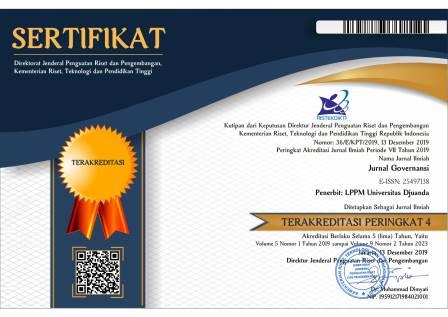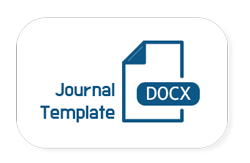Submissions
Submission Preparation Checklist
As part of the submission process, authors are required to check off their submission's compliance with all of the following items, and submissions may be returned to authors that do not adhere to these guidelines.- The submission has not been previously published, nor is it before another journal for consideration (or an explanation has been provided in Comments to the Editor).
- The submission file is in OpenOffice, Microsoft Word, RTF, or WordPerfect document file format.
- Where available, URLs for the references have been provided.
- The text is single-spaced; uses a 12-point font; employs italics, rather than underlining (except with URL addresses); and all illustrations, figures, and tables are placed within the text at the appropriate points, rather than at the end.
- The text adheres to the stylistic and bibliographic requirements outlined in the Author Guidelines, which is found in About the Journal.
- If submitting to a peer-reviewed section of the journal, the instructions in Ensuring a Blind Review have been followed.
Author Guidelines
SCOPE :
The GOVERNANSI Journal encourages the development of science and technology in the field of Public Administration by publishing scientific works based on (original) research results.
MANUSCRIPT TYPE:
The type of manuscript published is an original manuscript resulting from research that has never been published or is not in the process of publication by another publication media and is free from plagiarism. The publication language is Indonesian or English. Every manuscript submitted to the editorial board will undergo a peer-review process.
Research manuscripts must be based on original research data that has not been published and analyzed using statistical methods. Research manuscripts presented descriptively without a research design controlled by the researcher, which are merely repetitions of research results that have been published; for example, only the geographical conditions are different, will not be considered for publication. Manuscripts with serial numbers can only be accepted if submitted and presented simultaneously.
SENDING MANUFACTURES:
The submitted manuscript is addressed to the Leadership of the Governansi Journal Editorial Board:
Public Administration Study Program, Faculty of Social and Political Sciences Universitas Djuanda Bogor:
Address : Jl. Tol Ciawi No1. Po Box 35, Bogor 16720
Email : jurnal.governansi@unida.ac.id.
Phone : (0251) 824 0733/ 081546491011
CONVENTION AND OBSERVANCE:
The manuscript must be written in Time New Roman 12 font, double spaced, 2.5 cm margins, A4 size page, using the Microsoft Office Word program. The manuscript is written in no more than 7,500 words based on the following section order:
1) Title: TITLE in Indonesian and English, Author's Name, Author's Address, Author for Correspondence, and Short Title (Running Head).
2) Main section headings: ABSTRACT, ABSTRACT, INTRODUCTION, MATERIALS AND METHODS, RESULTS, DISCUSSION, CONCLUSIONS AND IMPLICATIONS, ACKNOWLEDGMENTS, BIBLIOGRAPHY.
3) Appendix: Tables, Graphs and Figures.
The title of the manuscript must be in bold and capital letters, written in the middle of a separate line. Headings and subheadings are written on separate lines, starting from the left edge of the text body. Headings are bold and capitalized. Subheadings are in bold and capital letters only at the beginning of the word. The distance between the header and subheading is 10 points (pt) while the distance between the header or subheading and the body of the text is 6 pt. The paragraph divider starts in the second paragraph after the header or subheading and is characterized by its first line being 0.5 cm from the left edge of the body of the text.
Manuscripts that are too long or too short will be returned to the author. As a guide, 7,500 words is equivalent to 34 A4 size pages, written in Time New Roman 12 font, double spaced, 2.5 cm margins from all page edges. Title no more than 12 words, Short Title no more than 50 characters, Abstract and Abstract each no more than 250 words, key words and keywords each 5 words, and Introduction no more than 500 words.
Title
The title must be concise and dense in information, not contain abbreviations, and contain the following:
a) generate interest for readers scanning a journal or list of journal titles.
b) Provide sufficient information for readers to assess the relevance of a manuscript to their interests
c) Include keywords or phrases that can be used in indexing and retrieving information about the research conducted.
d) Avoid unimportant words, such as “a case study ....” or “an empirical review of ....”. These things are more appropriately written in the Materials and Methods subsection.
e) May not contain place words, such as “.... in Bogor”
Author's Name and Address
The author's name and address must be presented as in the following example:
G. Pratidina1, a dan B.I. Maksudi2
1Institute for Research and Development Universitas Djuanda, Jl. Tol Ciawi Kotak Pos 35 Bogor 16720.
2Department of Public Administration, Faculty of Social and Political Sciences Universitas Djuanda, Jl. Tol Ciawi No. 1 Kotak Pos 35 Bogor 16720.
aKorespondensi: Ginung Praditina. Telefon: 085612345678; E-mail: ginung.praditina@unida.ac.id
Short Title (running head)
Authors must write a short title of no more than 50 characters including blank beats.
Abstract dan Abstrak:
Abstract consistently written in standard English (American English or British English).
Abstrak written in good and correct Indonesian, using standard words. Both abstracts and abstracts are written in one complete paragraph without any bibliographic references or references to tables and/or images, no more than 250 words. The contents must contain the important problems to be solved, objectives, methods, results, conclusions, and must not be too dense with numbers. Abbreviation of words is not permitted unless the word in question will be used more than once.
Keywords dan Kata Kunci:
Keywords (speak English) and Kata kunci (speak Indonesian), each of no more than five words and should not be the same as the words contained in the title of the manuscript. If it is inadequate, the editorial board will change it with the author's approval.
Introduction
The introduction, written in no more than 500 words, must explain current issues that lead to the importance of the research being conducted, the research objectives are stated clearly, and write the state of the art of the research topic so that the main picture of the research is clear to readers. However, literature references in the introduction must be limited because they are not an initial discussion.
Materials and methods
Research materials and methods must be explained in detail in this section so that it is possible for other researchers to repeat this research. The materials or ingredients used are not detailed separately, but must be integrated with research procedures. For example, .."respondents are asked to fill out a list of questions using a 2B pencil and choose one of three posters shown by the researcher...", there is no need to detail it as follows: "The research material consists of: a list of questions, a 2B pencil, and a poster. If the research uses a proprietary product (such as a patent) for comparison, the product in question must be written in a standard name or the trademark must be written in brackets if it is deemed to help clarify the reader's understanding, but the condition is that written permission must be obtained from the owner of the product in question before publication. The model, type, brand, and manufacturer of the equipment used in the study should be described. Statistical analysis methods and models must be clear so that it is possible for other researchers to repeat them.
The systematic writing is sorted as follows: material, experimental and treatment design, research implementation procedures, laboratory analysis, and statistical analysis. This systematics is not rigid, it can be adapted to the characteristics of the scientific field. For example, for agribusiness research that does not require laboratory analysis, there is no need for laboratory analysis. Conversely, other subsections can be added as needed.
Results and Discussion:
The research results, including the results of statistical analysis, are presented in detail in this section. Illustrations, if necessary, can be presented in the form of tables and/or pictures. Tables and figures must be simple, informative, easy to understand and independent, in the sense that the table or figure in question must be able to explain to the reader so that the reader does not have to read the text to understand it. Things that have been explained in tables or figures do not need to be repeated in writing. Tables and figures are contained on separate pages from the text.
The results of the research are then discussed by comparing them with the results of research on similar topics from previous researchers to reveal whether they are consistent (the same) or different, then explain the scientific reasons for the results in a straightforward and complete manner so as to clarify the position of the research results. Next, the research findings are disclosed along with the strengths and weaknesses, if any. Expressing the findings of this research will make it easier to conclude the research results.
<br />Treatment average data must be written with standard errors. The level of statistical significance can be expressed as P<0.05, P<0.01, and P<0.001. Specifically in tables, the level of significance referred to can be written with *, **, and *** respectively, while in tables and graphs, differences between treatments can be shown with the letters a, b for P<0.05 and A, B for P <0.01.
Conclusions and Implications
The conclusion contains research findings that reflect novelty, originality, pioneering, universality and scientific contributions to the development of science and technology. Statements in the conclusion are free from statistical phrases or terms, such as "..significant effect (P<0.05)"
Authors must explain the implications of their research results in scientific development, and their impact on the environment, social, cultural, economic, political and/or legal. The implications are presented in simple language so that non-scholarly readers can understand them easily.
Thank-you note
Acknowledgments must only be written if the research is supported (costs, facilities, personnel) by an agency or individual, or peer reviewers if the manuscript is reviewed before publication.
Bibliography
The author is responsible for the correctness of all library sources referred to and written in the Bibliography and those referred to in the text. It is highly recommended that library sources use the latest publications (last 10 years), and be presented alphabetically and written in year name format. Some formats and examples of writing include:
Journal manuscript or abstract. Format: Author's Name. Year. Title. Journal Name. Volume: Pages.
Example:
Rahmawati R, G Praditina dan RA Munjin. 2009. Model pelayanan rumah sakit berbasis karakteristik sosial ekonomi masyarakat untuk meningkatkan kepuasan pasien. Jurnal Humaniora. 1(1): 18–29.
Book. Format: Nama Penulis atau Nama Editor atau Nama Lembaga. Tahun. Judul. Edisi, Nama Penerbit, Tempat Penerbitan. Contoh:
Roestamy M. 2011. Konsep-konsep hukum kepemilikan properti bagi asing (dihubungkan dengan hukum pertanahan). Edisi pertama. PT. Alumni. Bandung.
Book chapters or proceedings. Format: Nama Penulis. Tahun. Judul. Dalam: Judul buku atau proseding (Nama Editor). Volume: Halaman. Nama Penerbit, Tempat Penerbitan. Contoh:
Goulet D. 2000. Ethics, culture and development: livestock, poverty and quality of rural life. In: Livestock, ethics and quality of life (eds. Hodges, John and Han, In K). 131-154. CABI Publishing, New York, NY 10016, USA.
Reports at scientific meetings (conferences, workshops, etc.) that are not covered in books or proceedings. Format: Author's Name. Year. Title. Title or Name of Scientific Meeting, Meeting Place. Number of pages. Example:
Jalal F. 2011. Tantangan dan peluang pendidikan di Indonesia. Orasi Ilmiah. Wisuda XXVI Sarjana dan Pascasarjana Universitas Djuanda, Bogor. 16 hal.
Thesis or Dissertation. Format: Nama Penulis. Tahun. Judul. Tesis atau Disertasi. Nama Perguruan Tinggi, Tempat Perguruan Tinggi. Contoh:
Roestamy M. 2008. Kepastian hukum atas kepemilikan rumah dan bangunan gedung oleh investor asing dikaitkan dengan asas nasionalitas dalam sistem hukum pertanahan Indonesia. Disertasi. Program Studi Doktor Ilmu Hukum Fakultas Hukum Universitas Padjadjaran, Bandung.
Freelance Scientific Work published on the Website. Freelance scientific work published on the website can only be used if other standard literature is not available. Format: Author's Name. Year. Title. Downloaded date-month-year from http://.... Example:
Bryant P. 1999. Biodiversity and Conservation. Retrieved October 4, 1999 from http://darwin bio.uci.edu/~sustain/bio65/Titlpage.htm
Writing the Author's Name Referred to in the Text
Author names referred to in the text are not permitted to be used in footnotes. If the number of authors is less than three, all authors' names are written, if the number of authors is not less than three, only the main author is written and followed by et al. Example: Syamsah (2010) concluded that taxes and zakat have a reductive and deductible relationship. Puskesmas service quality parameters simultaneously influence patient satisfaction (Yuningsih and Maulana 2010). Deficiencies in the quality of hospital services can be overcome if hospitals pay attention to patient characteristics (Rahmawati et al. 2010). The level of patient satisfaction is an important indicator in measuring the quality of health services (Yuningsih and Maulana 2010; Rahmawati et al. 2010).
Table
Tables should be as simple and minimal as possible, but must contain at least two rows of data. If there is only one line of data, then the presentation must use a graph. Table horizontal lines are only allowed to indicate the top line (heading) and bottom line of the table body, while table column lines are not permitted. Tables are created using the table function in the Microsoft Office Word program. Table titles must be concise, clear and informative, numbered sequentially in Arabic numerals, capitalized only on the first letter of the table title except for some proper names, and placed above the body of the table. Typically, variables are presented in rows and treatments are presented in table columns. Table captions are presented at the bottom of the table body without writing adverbs. In the text, table numbers must be referred to, for example: personality in the Islamic view is an integration of the heart, reason and passion systems (Table 1). Table titles, tables and table descriptions are presented on a separate page after the Bibliography. Table width 80 mm or 160 mm. Do not insert tables in text sections. Example Table width 80 mm:
Table 1 Percentage distribution of mental and natural powers in personality formation
Natural power
nafsani Tingkat kepribadian (%)
Muthmainnah Lawwamah Ammarah
Kalbu 55 30 15
Akal 30 40 30
Nafsu 15 30 55
Format tabel diubahsuai dari Sulaiman H (2010) tanpa mengubah substansi.
Images and Graphics
Images and graphs are made in JPEG format and are only permitted if the research data cannot be presented in tabular form. Graphics created using the Microsoft Office Excel program must be converted into JPEG format with image quality suitable for printing. The image width is 80 mm or 160 mm. Image titles must be concise, clear and informative, numbered sequentially in Arabic numerals, capitalized only on the first letter of the image title except for some proper names, and placed at the bottom of the image. Example of an 80 mm wide JPEG format image (Figure 1).
Figure 1
Image captions are written after and are an integral part of the image title. Images and image titles are presented on a separate page after the table page. In the text, all figure numbers must be referred to sequentially like table numbers. Images are printed in black and white and if the author wishes the image to be in color, the printing costs are the author's responsibility.
Freelance Print
Authors whose manuscripts have been published will receive one Governansi Journal and two reprint copies of their articles. Authors who wish to increase the number of journals and print publications can order it from the Editorial Board via telephone or email. The following is a price list for Governance Journals and loose prints, not including shipping costs.
Governance Journal price list and loose print
Number of Governansi Journals
(Rp/eksemplar) Cetak lepasnya*) (Rp/eksemplar)
1 - 5 75.000 30.000
6 atau lebih 60.000 25.000
*) pemesanan minimal 5 eksemplar.
Copyright Notice
Authors who publish with Jurnal Governansi agree to the following terms:
- Authors retain copyright and grant the journal right of first publication with the work simultaneously licensed under a Creative Commons Attribution 4.0 International License that allows others to share the work with an acknowledgement of the work's authorship and initial publication in Jurnal Governansi.
- Authors are able to enter into separate, additional contractual arrangements for the non-exclusive distribution of the journal's published version of the work (e.g., post it to an institutional repository or publish it in a book), with an acknowledgement of its initial publication in Jurnal Governansi.
- Authors are permitted and encouraged to post their work online (e.g., in institutional repositories or on their website) prior to and during the submission process, as it can lead to productive exchanges, as well as earlier and greater citation of published work.


















